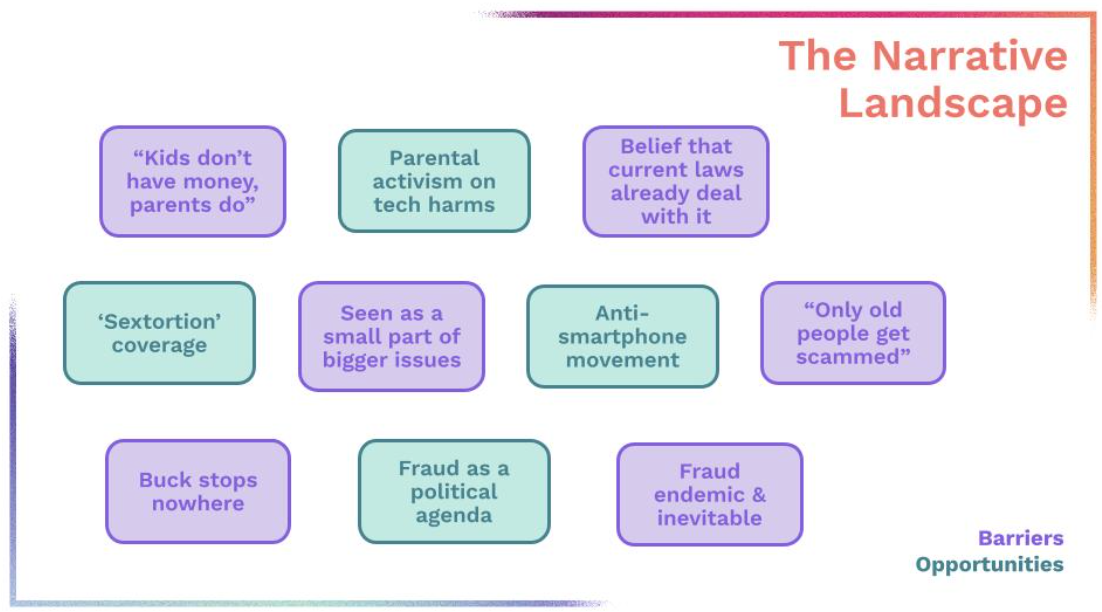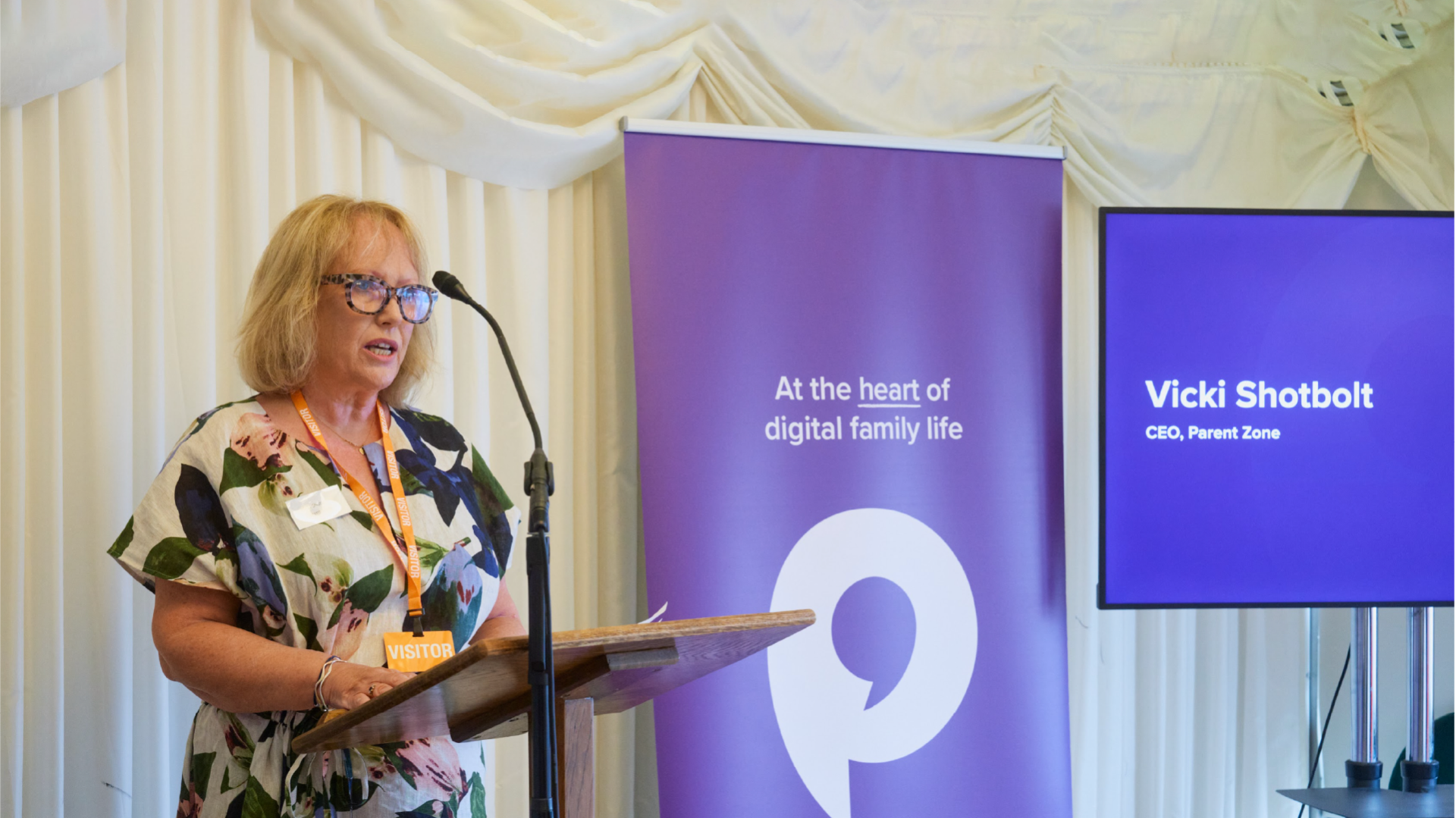Crafting a compelling public narrative for Child Financial Harms
By Daniel Stanley, Executive Director of Future Narratives Lab
In a perfect world, which social challenges become the focus of public interest and political debate would be decided through a fair, open and rational process, prioritised according to democratically agreed-upon criteria.
However, we all know that's unfortunately not at all the case.
Instead, even when the evidence is very clear that a major problem is emerging, causing damage to an increasing number of people, and with the potential to do far more, that’s no guarantee it will be noticed, let alone acted upon.
What determines whether an issue rises to attention is how well it can compete with others in the incredibly crowded and noisy spaces of political and public media, and whether a clear and compelling narrative can be found that cuts through to register with the intended audiences.
This challenge is particularly acute when working on a topic that is novel, complex and multifaceted, mapping across the categories and definitions that we have traditionally used, without falling neatly into any one of them.
In these cases, providing a clear and coherent explanation of the issue, that is comprehensible, let alone persuasive, for key stakeholders and decision makers, becomes a significant first hurdle to real action to address it.
Such is undoubtedly the case with the issue of Child Financial Harms — a ‘wicked problem’ that is ‘hiding in plain sight’, as research has defined it.
Despite clear evidence that a growing number of children and parents are becoming victims of this growing trend, far too little attention has been paid to it as a matter of urgent concern and necessary collective action.
Identifying Opportunities & Barriers
This was the challenge we were presented with at Future Narratives Lab in the Summer of 2024 — to create a new way of communicating about this topic that could overcome its inherent challenges and complexities, and make it feel comprehensible and urgent to decision makers.
In most of the work we do, we find a necessary foundation is to map the landscape of concepts, beliefs and narratives around the issue, to identify the context within which an issue is currently situated, and where there might be particular barriers or overlaps, as well as possible gaps and opportunities.
Fortunately, the Consortium already had a strong bank of research to work from, including qualitative research with parents, children and others. Analysis of this existing work, along with conversations with the consortium and partners, allowed us to quickly establish a broad representation of relevant ideas and debates we could engage with, or needed to counter.

Four Framing Components
Based on this initial analysis and mapping, we then worked with the partnership to establish a set of core principles to guide the development of a new narrative approach for the topic. Utilising the classic definition by Entman (1993) of the necessary components of effective framing, this constituted:
- Firstly, a solid Problem Definition, that situated the issue within the context of existing understandings of child technology use (i.e. mass adoption of gaming, screen time debates).
- Secondly, ensuring the narrative had a clear Causal Interpretation, that properly outlined the how and why of the fundamental shift that had occurred for this issue to arise (increasing financialisation of childhood).
- Next, a careful selection of the ‘right’ examples of harms to lead with, to contribute to the desired Moral Evaluation within the intended audience, and avoid the range of harms being misrepresented.
- Finally, a fair, adequate and understandable allocation of responsibility for action, as part of a sufficient Treatment Recommendation, to guard against a ‘passing the buck’ effect that had been observed up until this point.
With these four components in place and agreed, we were able to start developing and testing a more fleshed-out narrative approach in practice.
Developing and testing a new narrative
Essentially, what we wanted to develop was a way of translating the complex reality of the issue into something that would be interesting and motivating, even for people with many competing issues and priorities, while remaining a true representation of the realities.
To achieve this balance, as we developed our explanatory narrative approach, we refined and tested it through conversations with individuals both within the Consortium and without. In the latter case, we sought out two experienced journalists to get immediate and direct feedback on how well our emerging explanations.
Broadly, we built our approach around a set of key frames, developed out of the principles above. You can access the full Messaging Guide via the form linked below, but to give a sample, they included:
- Directly countering the misconception that fraud is only a problem that impacts older people
- Using the huge rise in ubiquity of online gaming as a recognisable explanatory vehicle for the sudden emergence of this issue
- Asking a rhetorical question as to whether we wanted the first financial education that our society's children experience to take place in a fraudulent, unregulated space
- Clearly stating financialisation as the driver of this phenomenon, and who has responsibility to address it
These were knitted together into a narrative arc, an early version of which was tested out with Jamie Bartlett, a tech journalist, podcaster, and online scams specialist, and Leyla Boulton, a senior editor at the Financial Times.
These conversations gave us incredibly useful feedback that we used to hone and improve the eventual outputs we produced — but they were also a reassurance that we were on the right track. Unprompted, Jamie’s reaction to our early-stage test was to write a great post about the topic for his popular Substack - generating immediate media coverage was a welcome bonus output at this stage of the project.
A Messaging Guide
The last stage of the project was about finalising our approach, and documenting it in the form of a Messaging Guide that could then be circulated and used in future communications by the members of the consortium and beyond, to enhance and support continuing efforts to bring wider awareness to the issue, particularly among Media and Policy Audience. The Guide, which can be accessed through this link, contains:
- Six Key Frames that define the approach recommended
- A Core Story, to act as a coherent narrative thread that connects the key frames into a compelling and complete explanation, and act as a reference point to help ensure consistent messaging across different communications and contexts
- Audience Guidance to suggest how approaches might be adapted for different groups
- A set of Expected Critiques and Responses to prepare for anticipated pushback
- A table of key ‘Do’s and Don’ts’ for easy review when creating communications materials.
Collectively, this guide is intended as a concise and practical framework, to enable varied but fundamentally consistent and effective communication on the topic across a range of contexts.
Lessons & Future Steps
In July 2025, we were pleased to reconnect with the Consortium at a Reception in Parliament for Parent Zone, hosted by Jim Shannon MP.
Listening to the speeches being made by different members of the consortium, it was great to see different elements of the narrative and messaging work clearly coming through, and be told afterwards how useful different organisations are finding it.
Also presented at the event was new research by Ofcom explicitly looking at the issue of Child Financial Harms — we will claim no credit for this significant sign of progress and increased recognition, but it is great to see the increasing acknowledgement of the problem, and adoption of the related language at the highest levels.
This kind of influence among regulators and other professional bodies will be a key necessary component of starting to address the issue fully, but there is a long way to go. While our work on the Narrative and Messaging Guide was most focussed on more professional and policy audiences, the nature of politics is that for urgent action to be taken, and resources spent, public pressure is needed.
This again will be no easy task. While more effective narratives and messaging can help, there are additional barriers to engaging the public, and in particular parents who would be the natural constituency for such an effort, in any such campaign. As research by Parent Zone has shown, parents in particular still have mixed feelings about online scams, often feeling a sense of personal responsibility for financial competence, and a reluctance to accept that there are problems they can’t deal with on their own.
That said, as our research identified, in touching on many of the most relevant and topical issues that we face as a society today, there is great potential for a more public-focussed campaign around this topic. It could help provide children and families across the country with an explanation for the realities of what they are experiencing, and give victims of fraud and scams an opportunity for collective action, rather than the guilt and shame which is all too often the response. With some further design and development, focussed on parents, and working specifically to overcome the emotional and cultural barriers to engagement, the opportunity to build a powerful movement for change awaits.
Daniel Stanley is Executive Director of Future Narratives Lab, a nonprofit Research & Development initiative that focuses on working with campaigns, coalitions and civil society to overcome narrative barriers and develop new strategies and messaging to broaden their influence. You can also follow Daniel on LinkedIn.

